

This section describes static properties of atoms and atomic ions such as state energy, total angular momentum, composition of the wave function with mixing coefficients, etc.
The element Atoms of type AtomsType is a container for one or more Atom elements of type AtomType.

AtomType is an extension of PrimaryType, additionally containing
- mandatory element ChemicalElement of type ChemicalElementType
- one or more Isotope elements of type IsotopeType.

Isotope element of IsotopeType defines a sequence containing
- optional IsotopeParameters element of type IsotopeParametersType,
- one or more Ion elements of type AtomicIonType,
- optional Comments element of type xs:string.
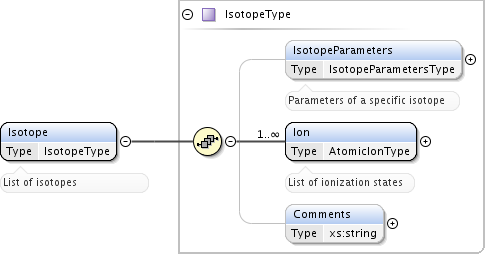
IsotopeParameters element, having type IsotopeParametersType, is an extension of PrimaryType, defining additionally:
- mandatory integer element MassNumber that is the total number of nucleons (protons plus neutrons).
- optional element Mass of type DataType
- optional element NuclearSpin of type AngularMomentumType.
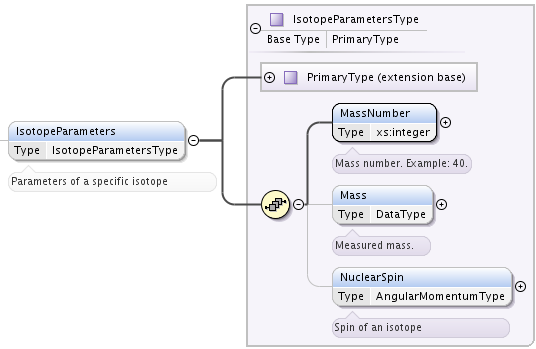
Ion element, with type AtomicIonType, is an extension of PrimaryType, defining additionally:
- mandatory speciesID attribute for referencing this atom from processes or environments
- mandatory IonCharge integer element
- optional IsoelectronicSequence element of type ElementSymbolType
- none or one or more AtomicState elements of type AtomicStateType
- optional InChI element to keep [INCHI] identifier for atom
- mandatory InChIKey element for [INCHIKey] of this ion. InChIKey element is mandatory since it is a fast and reliable way to see if we are talking about the same element, when comparing data originating from different sources.
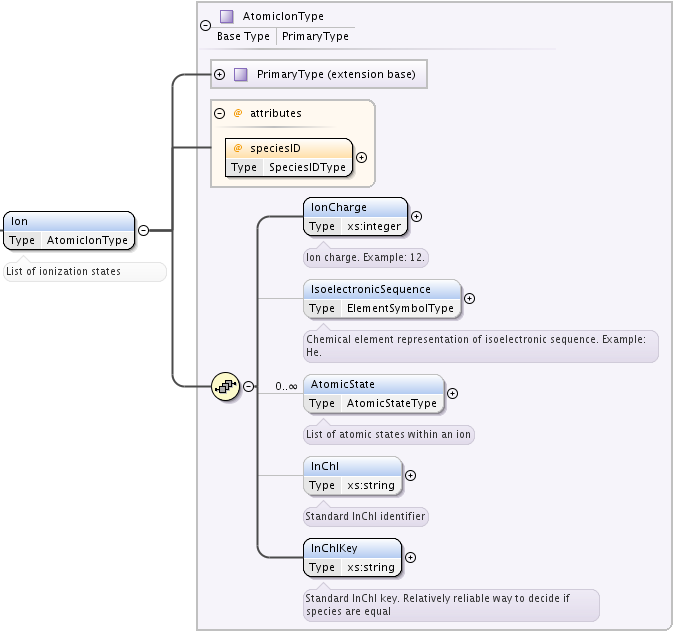
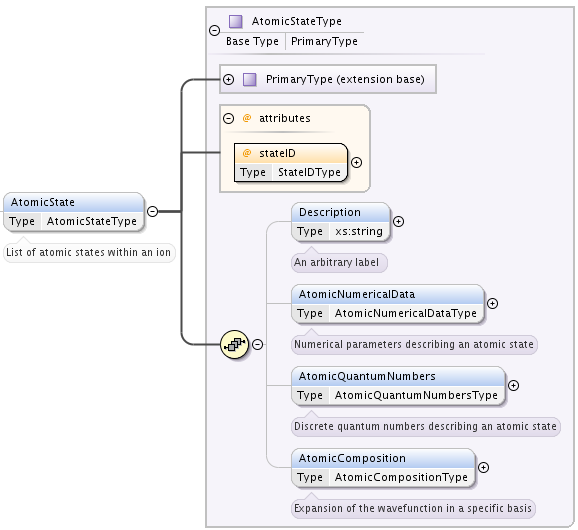
AtomicState element of type AtomicStateType, again extending PrimaryType, holds all information about specific atomic states and defines following attributes and elements:
- mandatory stateID attribute of type StateIDType that is used to refer to this specific state from processes branch,
- optional string Description element that may contain short description or some label of state,
- optional AtomicNumericalData element of type AtomicNumericalDataType that may contain numerical information about state,
- optional AtomicQuantumNumbers element of type AtomicQuantumNumbersType that has elements for atomic quantum numbers describing the state,
- optional AtomicComposition element of type AtomicCompositionType that may contain wavefunction expansion in a specific basis.
An atomic state is the superposition of the quantum state for each electron in the atom. The quantum numbers for individual electron, or for groups of equivalent electrons, are written in the Component elements within the AtomicComposition element. Quantum numbers describing the atomic state as a whole are written in the AtomicQuantumNumbers element.
To identify a state fully by its quantum numbers we need the electronic configuration, the coupling term for spin-orbit interactions, the total angular momentum, the overall parity and the magnetic quantum number. The configuration and coupling term are part of the AtomicComposition; the total angular momentum, magnetic quantum number and the parity are part of the AtomicQuantumNumbers.
AtomicNumericalData element, extension of the PrimaryType that may contain the following optional elements:
- StateEnergy (above the ion ground state)
- IonizationEnergy,
- LandeFactor,
- QuantumDefect,
- LifeTime of LifeTimeType,
- Polarizability,
- StatisticalWeight,
- HyperfineConstantA,
- HyperfineConstantB.
Most of these elements are of type DataType. State lifetime has an optional attribute, describing the decay mechanism. The statistical weight of a free atom/ion is an integer, however, in a plasma it can become non-integer and therefore here StatisticalWeight is assumed to be a real number.
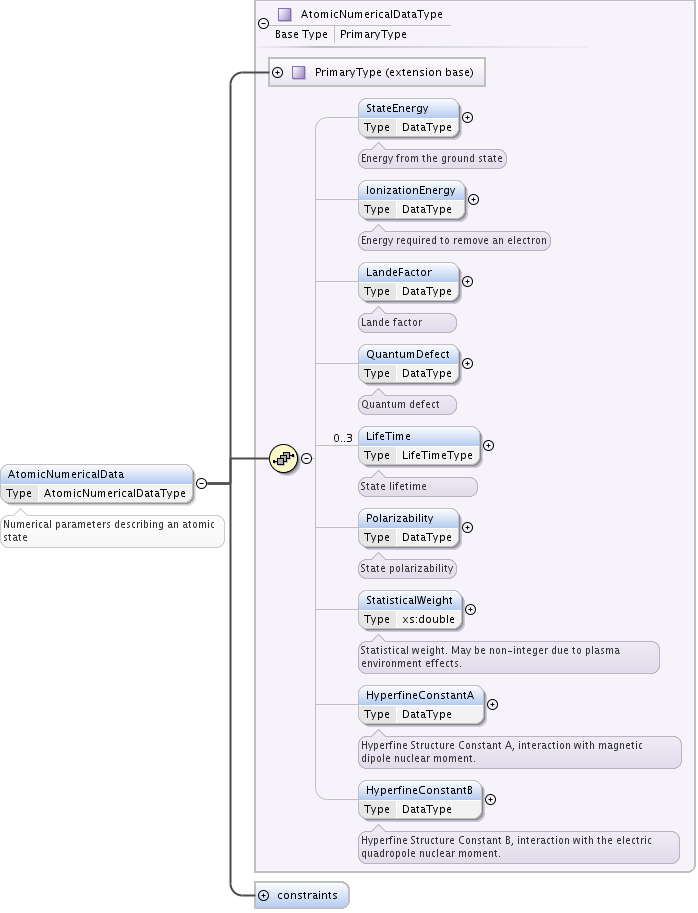
Represents quantum numbers of an atomic state. Following elements are defined:
- Parity of type ParityType,
- TotalAngularMomentum,
- Kappa relativistic parameter,
- and HyperfineMomentum of AngularMomentumType
- MagneticQuantumNumber of type AngularMomentumProjectionType.
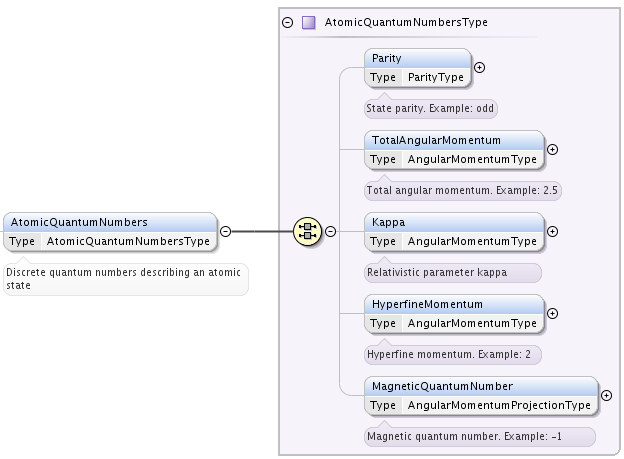
Extension of the PrimaryType. Contains components of the atomic wavefunction in a specific basis. Each Component element is of type AtomicComponentType.
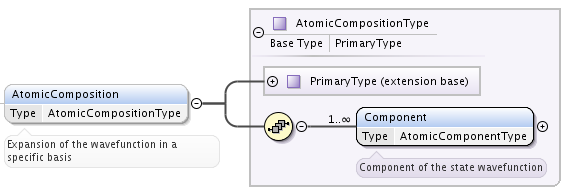
Describes individual components of the atomic wavefunction in a specific basis. May contain elements:
- SuperConfiguration of SuperconfigurationType,
- Configuration of ConfigurationType,
- Term of type TermType,
- MixingCoefficient of MixingCoefficientType MixingCoefficientType is an extension of XML type double with the mandatory attribute mixingClass, that indicates the nature of the mixing coefficients in the expansion of a wave function in a specific basis. Allowed values of mixingClass attribute are: - squared - signed
- Comments string element
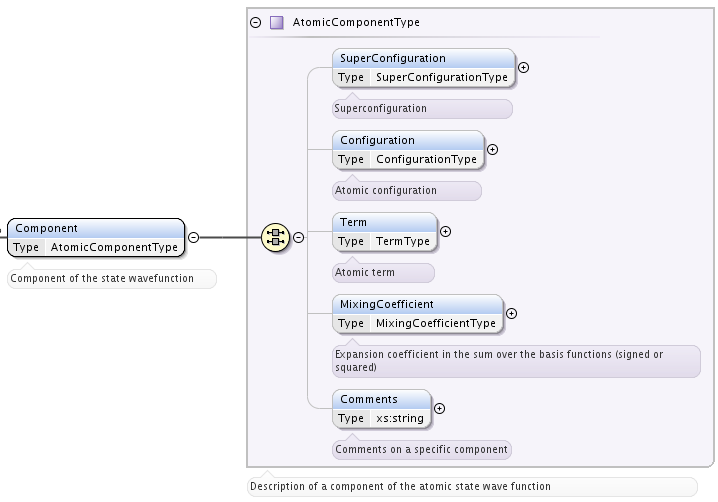
Contains one or more Supershell elements (type SupershellType), that is, electron distribution over atomic supershells.
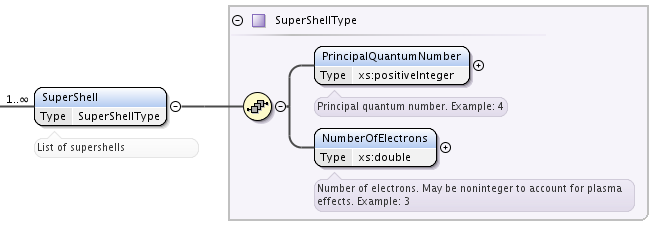
Each SuperShell element describes how many electrons populate a specific supershell characterized by a positive-integer principal quantum number n. The element NumberOfElectrons of type xs:double can be non-integer to take into account possible plasma effects.
The element PrincipalQuantumNumber is of type xs:positiveinteger.
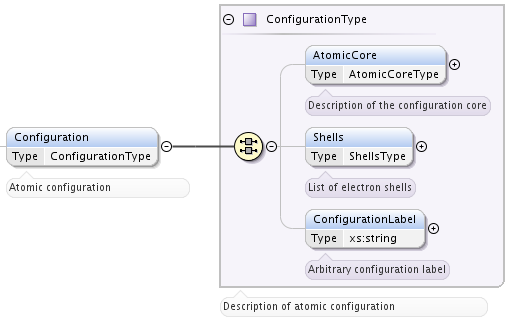
Describes how electrons are distributed over nl shells. May contain:
- optional AtomicCore element (type AtomicCoreType), that is used to compactly represent the atomic core. For instance, one may prefer to use notation [Ne]3d to describe the excited configuration 1s^22s^22p^63d in a Na-like ion. In this case, it would be sufficient to only indicate the ElementCore element, which will be Ne.
- optional Shells (type ShellsType) that contains list of electronic shells or shell pairs
- string ConfigurationLabel, that is used to represent configuration in a condensed form, if necessary. For instance, one may prefer to make use of a short configuration label 2s2.2p instead of providing details of shell populations etc.
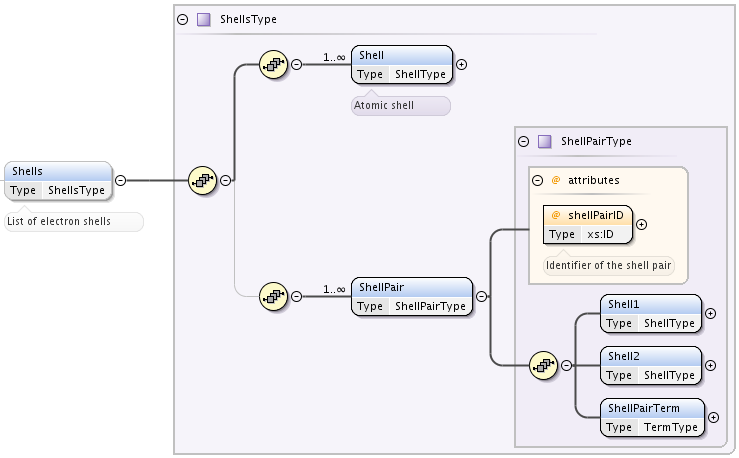
The shells in a configuration can be represented both individually and in terms of shell pairs. ShellPair describe a coupled pair of atomic shells. In addition to descriptors for each of the shells, it contains the mandatory attribute shellPairID to be referenced in a document.
Here, XML types, specific to Species.Atoms branch of XSAMS are described
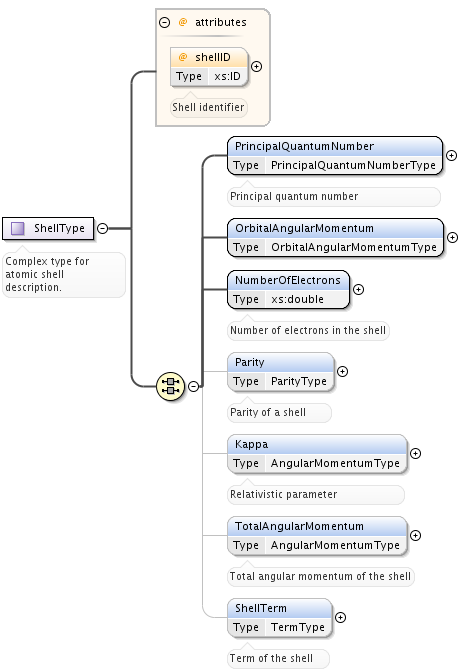
As an atomic shell is typically represented as nl^w , all three parameters:
- PrincipalQuantumNumber n,
- OrbitalAngularMomentum l, and
- NumberOfElectrons w are mandatory. NumberOfElectrons may be a non-integer decimal number in order to reflect plasma effects.
Other optional parameters include * Parity element (type ParityType), * TotalAngularMomentum element (type AngularMomentumType) * \kappa relativistic parameter (element Kappa of type AngularMomentumType), * ShellTerm element (type TermType) * optional attribute shellID (type xs:ID).
Currently an atomic term can be represented in five coupling schemes, i.e., LS, jj, J_1J_2, jK, and LK. For a detailed description of these and other schemes see, e.g., Atomic Spectroscopy at http://physics.nist.gov/Pubs/AtSpec/index.html
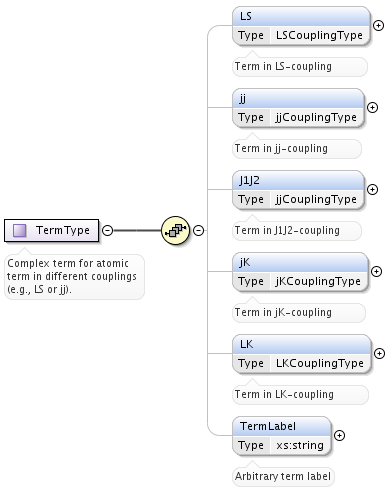
For each coupling, a separate XML type is defined:
LSCouplingType Describes LS-coupling in an atomic term in terms of total angular orbital momentum L (type OrbitalAngularMomentumType) and total spin S (type AngularMomentumType). Optional element Multiplicity is defined as 2S+1 and therefore always is a positive integer. Optional element Seniority is a non-negative integer with an optional attribute soureceRef.
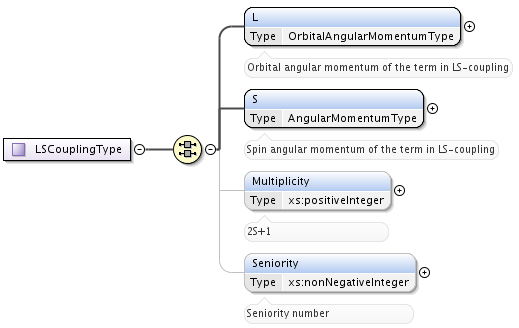
jjCouplingType Describes jj-coupling in an atomic term as two or more j-values (each of AngularMomentumType).

J1J2CouplingType Describes J_1J_2-coupling in an atomic term as two or more j-values (each of AngularMomentumType). Similar to the jj-coupling.
jKCouplingType Describes jK-coupling in an atomic term typical in, e.g., noble-gas-like ions. The K quantum number is mandatory, while the core momentum j and the spin of outer electron(s) S2 are optional; each of them is of AngularMomentumType.
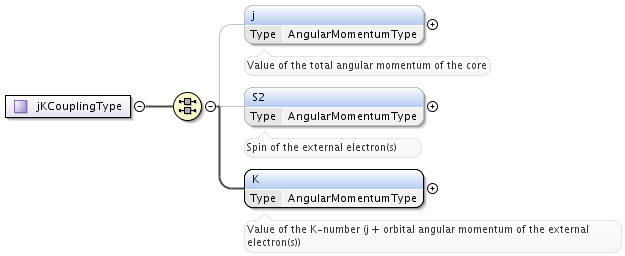
LKCouplingType Describes LK - coupling (or LS_1) in an atomic term in terms of atomic core angular momentum L and its sum with the total spin of the core: \overrightarrow{K} = \overrightarrow{L}+\overrightarrow{S_1}. The spin of outer electron(s) S2 is an optional element of type AngularMomentumType.
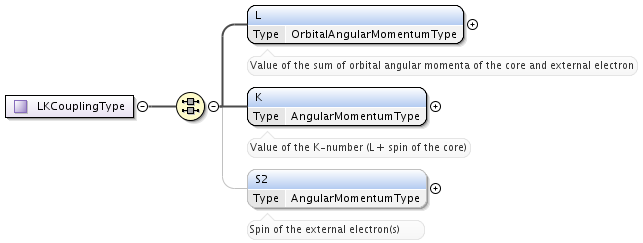
TermLabel This string element is used to represent an atomic term in a condensed form, if necessary. For instance, one may prefer to make use of a term label 3P instead of separately indicating the term S and L values.
Represents an orbital angular momentum as a mandatory non-negative integer Value and an optional lower-case letter Symbol (example: p).

Example instances of Species.Atoms branch subtrees:
Example from VALD database for \mathrm{Fe}^{2+}, with two states present:
<Atom>
<ChemicalElement>
<NuclearCharge>26</NuclearCharge>
<ElementSymbol>Fe</ElementSymbol>
</ChemicalElement>
<Isotope>
<IsotopeParameters>
<MassNumber>56</MassNumber>
</IsotopeParameters>
<Ion speciesID="Xvald-328">
<IonCharge>2</IonCharge>
<AtomicState stateID="Svald-7776">
<AtomicNumericalData>
<StateEnergy>
<SourceRef>Bvald-K10</SourceRef>
<SourceRef>Bvald-K10M</SourceRef>
<SourceRef>Bvald-K10Q</SourceRef>
<Value units="1/cm">201170.1000</Value>
</StateEnergy>
</AtomicNumericalData>
<AtomicQuantumNumbers>
<TotalAngularMomentum>2.0</TotalAngularMomentum>
</AtomicQuantumNumbers>
<AtomicComposition>
<Component>
<Term>
<LS>
<L>
<Value>2.0</Value>
</L>
<S>1.0</S>
</LS>
</Term>
</Component>
</AtomicComposition>
</AtomicState>
<AtomicState stateID="Svald-7788">
<AtomicNumericalData>
<StateEnergy>
<SourceRef>Bvald-K10</SourceRef>
<SourceRef>Bvald-K10M</SourceRef>
<SourceRef>Bvald-K10Q</SourceRef>
<Value units="1/cm">105895.3500</Value>
</StateEnergy>
<LandeFactor>
<SourceRef>Bvald-K10</SourceRef>
<SourceRef>Bvald-K10M</SourceRef>
<SourceRef>Bvald-K10Q</SourceRef>
<Value units="unitless">0.50</Value>
</LandeFactor>
</AtomicNumericalData>
<AtomicQuantumNumbers>
<TotalAngularMomentum>2.0</TotalAngularMomentum>
</AtomicQuantumNumbers>
<AtomicComposition>
<Component>
<Term>
<LS>
<L>
<Value>1.0</Value>
</L>
<S>1.0</S>
</LS>
</Term>
</Component>
</AtomicComposition>
</AtomicState>
<InChI>InChI=1S/Fe/q+2/</InChI>
<InChIKey>CWYNVVGOOAEACU-IGMARMGPSA-N</InChIKey>
</Ion>
</Isotope>
</Atom>
In the following example, the quantum description is sufficient to identify the energy level but not the states within each level; the magnetic quantum-number is not given. I.e. the description ignores the Zeeman splitting of energy levels in a magnetic field.
The electronic configuration is specified as an iso-electronic core and a shell of valence electrons. The core, [Ne] in this case, contains electrons whose quantum numbers match those in a Neon atom in its ground state. The core consists entirely of full shells and hence its equivalent atom is one of the noble gases. The valence shell is denoted by a list of Shell elements, each one describing a sub-shell or equivalent electrons.
The spin-orbit coupling is given in the Russell-Saunders (LS) scheme, by a Term element. The coupling is described for the entire state by a single term, so the state is considered to have a single Component.
The parity of the state is not given explicitly, but is can be determined from the orbital angular moment of the electrons in the valence shell. In the state shown, the sum of these momenta is an odd number so the parity is odd.
From the given mark-up, the state can be identified and matched as [Ne] 3s^{1} 3p^{1} 3P^{o}_{0.0}
<Atom>
<ChemicalElement>
<NuclearCharge>22</NuclearCharge>
<ElementSymbol>Ti</ElementSymbol>
</ChemicalElement>
<Isotope>
<Ion speciesID="Xchianti-10022">
<IonCharge>10</IonCharge>
<AtomicState stateID="Schianti-2010022">
<Description>3s 3p</Description>
<AtomicNumericalData>
<StateEnergy methodRef="Mchianti-EXP">
<Value units="1/cm">173200.0</Value>
</StateEnergy>
</AtomicNumericalData>
<AtomicQuantumNumbers>
<TotalAngularMomentum>0.0</TotalAngularMomentum>
</AtomicQuantumNumbers>
<AtomicComposition>
<Component>
<Configuration>
<AtomicCore>
<ElementCore>Ne</ElementCore>
<Term/>
</AtomicCore>
<Shells>
<Shell>
<PrincipalQuantumNumber>3</PrincipalQuantumNumber>
<OrbitalAngularMomentum>
<Value>0</Value>
</OrbitalAngularMomentum>
<NumberOfElectrons>1</NumberOfElectrons>
<ShellTerm/>
</Shell>
<Shell>
<PrincipalQuantumNumber>3</PrincipalQuantumNumber>
<OrbitalAngularMomentum>
<Value>1</Value>
</OrbitalAngularMomentum>
<NumberOfElectrons>1</NumberOfElectrons>
<ShellTerm/>
</Shell>
</Shells>
</Configuration>
<Term>
<LS>
<L>
<Value>1</Value>
</L>
<S>1.0</S>
</LS>
</Term>
</Component>
</AtomicComposition>
</AtomicState>
…